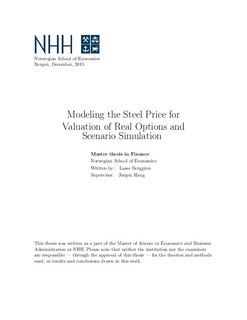Modeling the steel price for valuation of real options and scenario simulation
Master thesis
Permanent lenke
http://hdl.handle.net/11250/2383142Utgivelsesdato
2015Metadata
Vis full innførselSamlinger
- Master Thesis [4372]
Sammendrag
Steel is widely used in construction. I tried to model the steel price such that valuations
and scenario simulations could be done. To achieve a high level of precision this is
done with a continuous-time continuous-state model. The model is more precise than a
binomial tree, but not more economically interesting. I have treated the nearest futures
price as the steel price. If one considers options expiring at the same time as the futures,
it will be the same as if the spot were traded. If the maturity is short such that details
like this matters, one should treat the futures as a spot providing a convenience yield
equal to the interest rate earned on the delayed payment. This will in the model be
the risk-free rate.
Then I have considered how the drift can be modelled for real world scenario simulation.
It involves discretion, as opposed to finding a convenient AR(1) representation,
because the ADF-test could not reject non-stationarity (unit root).
Given that the underlying is traded in a well functioning market such that prices
reflect investors attitude towards risk, will the drift of the underlying disappear in the
one-factor model applied to value a real-option. The most important parameter for the
valuation of options is the volatility. I have estimated relative and absolute volatility.
The benefit of the relative volatility is the non-negativity feature.
Then I have estimated a model where the convenience yield is stochastic. This
has implications for the risk-adjusted model. I have difficulties arriving at reliable
parameter estimates. Here small changes in arguments have large effects on the option
value. Therefore should this modelling be carried through only if one feels comfortable
that it is done properly.
I finish by illustrating how real-option valuation can be performed. The trick is to
translate the real-world setting into a payoff function. Then one can consider Monte
Carlo simulation if the payoff function turns out to be complicated or if there are
decisions to be made during the life of the project. For projects maturing within the
horizon traded at the exchange, the expectation of the spot price under the pricing
measure is observable.
To truly compare models, plots of the value of derivative should be created to
graphically compare the difference in dependence on parameter values. Alternatively,
the derivative of the expressions with respect to the parameters are compared. The
value of the option to do something, as opposed to be committed to do something,
increases with the volatility of future outcomes. Such known results are used instead
in the comparison, because the two reliable models (the one-factor models) are pretty
similar. This known result is not contradicted by the present values computed in the
real option example.
